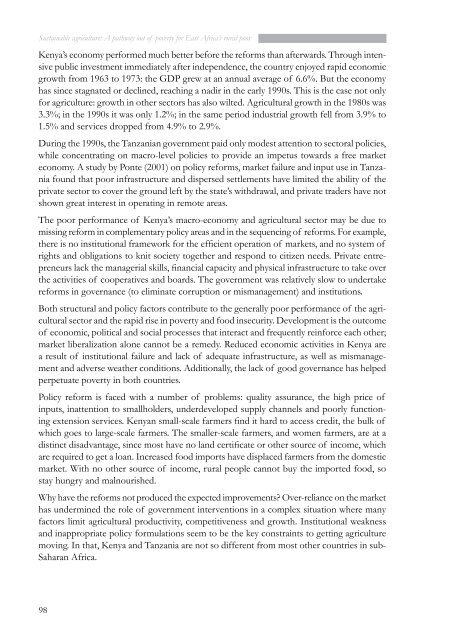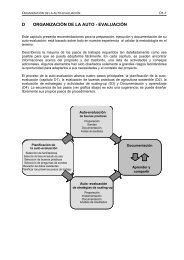cases from tanzania - Sustainet
cases from tanzania - Sustainet
cases from tanzania - Sustainet
Create successful ePaper yourself
Turn your PDF publications into a flip-book with our unique Google optimized e-Paper software.
Sustainable agriculture: A pathway out of poverty for East Africa’s rural poor<br />
Kenya’s economy performed much better before the reforms than afterwards. Through intensive<br />
public investment immediately after independence, the country enjoyed rapid economic<br />
growth <strong>from</strong> 1963 to 1973: the GDP grew at an annual average of 6.6%. But the economy<br />
has since stagnated or declined, reaching a nadir in the early 1990s. This is the case not only<br />
for agriculture: growth in other sectors has also wilted. Agricultural growth in the 1980s was<br />
3.3%; in the 1990s it was only 1.2%; in the same period industrial growth fell <strong>from</strong> 3.9% to<br />
1.5% and services dropped <strong>from</strong> 4.9% to 2.9%.<br />
During the 1990s, the Tanzanian government paid only modest attention to sectoral policies,<br />
while concentrating on macro-level policies to provide an impetus towards a free market<br />
economy. A study by Ponte (2001) on policy reforms, market failure and input use in Tanzania<br />
found that poor infrastructure and dispersed settlements have limited the ability of the<br />
private sector to cover the ground left by the state’s withdrawal, and private traders have not<br />
shown great interest in operating in remote areas.<br />
The poor performance of Kenya’s macro-economy and agricultural sector may be due to<br />
missing reform in complementary policy areas and in the sequencing of reforms. For example,<br />
there is no institutional framework for the efficient operation of markets, and no system of<br />
rights and obligations to knit society together and respond to citizen needs. Private entrepreneurs<br />
lack the managerial skills, financial capacity and physical infrastructure to take over<br />
the activities of cooperatives and boards. The government was relatively slow to undertake<br />
reforms in governance (to eliminate corruption or mismanagement) and institutions.<br />
Both structural and policy factors contribute to the generally poor performance of the agricultural<br />
sector and the rapid rise in poverty and food insecurity. Development is the outcome<br />
of economic, political and social processes that interact and frequently reinforce each other;<br />
market liberalization alone cannot be a remedy. Reduced economic activities in Kenya are<br />
a result of institutional failure and lack of adequate infrastructure, as well as mismanagement<br />
and adverse weather conditions. Additionally, the lack of good governance has helped<br />
perpetuate poverty in both countries.<br />
Policy reform is faced with a number of problems: quality assurance, the high price of<br />
inputs, inattention to smallholders, underdeveloped supply channels and poorly functioning<br />
extension services. Kenyan small-scale farmers find it hard to access credit, the bulk of<br />
which goes to large-scale farmers. The smaller-scale farmers, and women farmers, are at a<br />
distinct disadvantage, since most have no land certificate or other source of income, which<br />
are required to get a loan. Increased food imports have displaced farmers <strong>from</strong> the domestic<br />
market. With no other source of income, rural people cannot buy the imported food, so<br />
stay hungry and malnourished.<br />
Why have the reforms not produced the expected improvements? Over-reliance on the market<br />
has undermined the role of government interventions in a complex situation where many<br />
factors limit agricultural productivity, competitiveness and growth. Institutional weakness<br />
and inappropriate policy formulations seem to be the key constraints to getting agriculture<br />
moving. In that, Kenya and Tanzania are not so different <strong>from</strong> most other countries in sub-<br />
Saharan Africa.<br />
98




